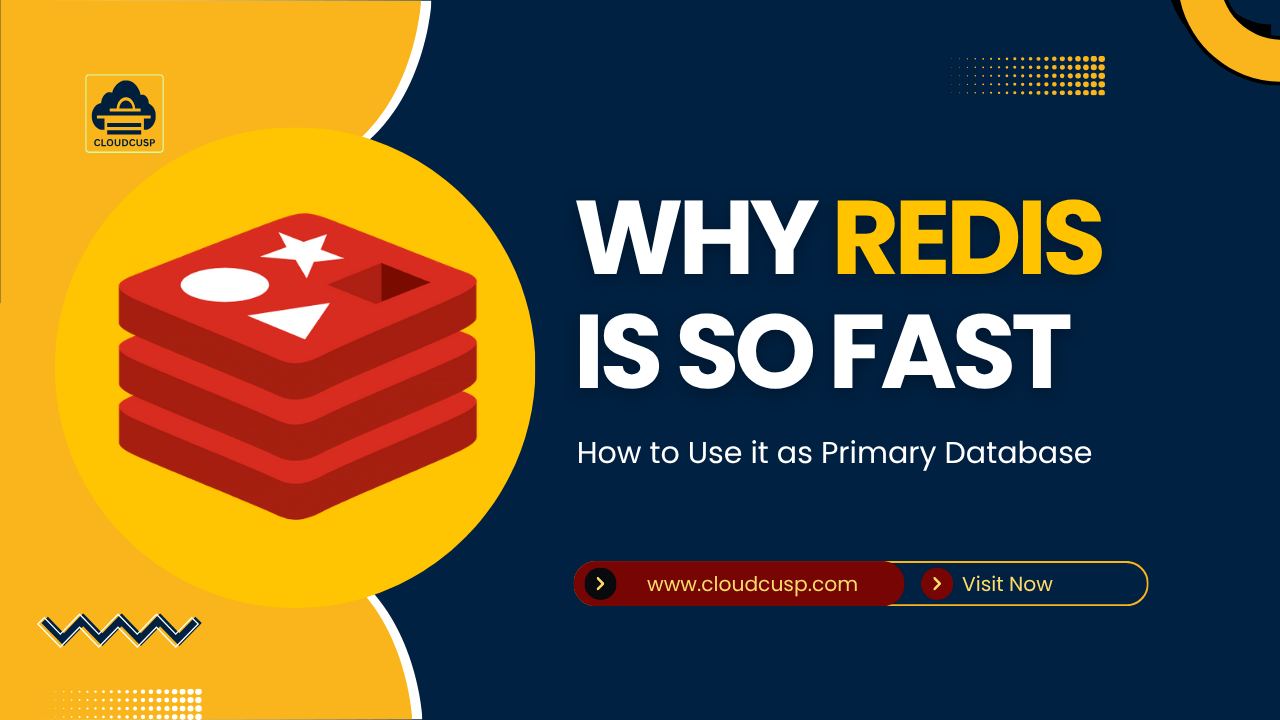Key Takeaways
- Redis is an in-memory powerhouse that stores data like keys and values, supporting lists, sets, and more for lightning-quick access.
- It’s ideal as a primary database for speed-focused apps (e.g., gaming or social feeds), but watch for memory limits and persistence needs.
- Getting started is simple: install, connect, and use basic commands—scale later with clustering for bigger loads.
Redis, which stands for Remote Dictionary Server, is an open-source, in-memory data structure store that can be used as a database, cache, message broker, and more. Originally created by Salvatore Sanfilippo in 2009, Redis has gained immense popularity among developers for its speed, flexibility, and simplicity.
Unlike traditional databases that store data on disk, Redis primarily keeps data in RAM, which makes it incredibly fast. This speed advantage has made Redis a popular choice for caching, but its capabilities extend far beyond that. In recent years, many organizations have started using Redis as their primary database for certain types of applications.
On This Page
Table of Contents
What Makes Redis Different?
Redis differs from traditional databases in several fundamental ways:
In-Memory Storage
The most significant difference is that Redis stores data primarily in RAM rather than on disk. This design choice allows for extremely fast read and write operations. While traditional databases typically have access times measured in milliseconds, Redis operations often complete in microseconds.
Data Structure Diversity
Redis isn’t just a simple key-value store. It supports multiple data structures including:
- Strings: Basic text or binary data up to 512MB in size
- Hashes: Collections of field-value pairs
- Lists: Collections of string elements ordered by insertion
- Sets: Unordered collections of unique string elements
- Sorted Sets: Similar to sets but with an associated score for ordering
- Bitmaps: Bit-level operations on strings
- HyperLogLogs: Probabilistic data structures for counting unique elements
- Streams: Append-only log-like data structures
Single-Threaded Architecture
Redis uses a single-threaded architecture for command processing, which eliminates the need for locking mechanisms and simplifies the codebase. This design choice might seem counterintuitive in a multi-core world, but it works exceptionally well for Redis’s use case because most operations are memory-bound rather than CPU-bound.
Why Use Redis as a Primary Database?
While Redis is commonly used as a cache, there are compelling reasons to consider it as your primary database for certain applications:
Blazing Speed
The most obvious advantage is speed. With data stored in memory and a simple, efficient architecture, Redis can handle hundreds of thousands to millions of operations per second. This makes it ideal for applications that require real-time responses, such as:
- Gaming leaderboards
- Real-time analytics
- Session management
- Messaging systems
- Content delivery networks
Rich Data Structures
Redis’s diverse data structures allow you to model your application data more naturally. Instead of mapping complex objects to relational tables, you can often use Redis data structures that more closely match your application’s needs.
For example, a leaderboard can be implemented using a Sorted Set, where each player is a member and their score is the sorting key. This provides O(log N) time complexity for updates and retrievals, which is much more efficient than equivalent operations in a relational database.
Simplicity and Ease of Use
Redis has a simple command-line interface and client libraries for virtually every programming language. Its straightforward API makes it easy to learn and use, reducing development time and complexity.
Scalability
Redis offers several options for scaling:
- Horizontal scaling through Redis Cluster
- Read replicas for handling read-heavy workloads
- Sharding for distributing data across multiple nodes
Persistence Options
Despite being an in-memory database, Redis offers several persistence options:
- RDB (Redis Database): Periodic snapshots of the dataset
- AOF (Append Only File): Log of every write operation
- Hybrid approach: Combining RDB and AOF for the best of both worlds
These options ensure that your data isn’t lost if the server restarts, addressing one of the primary concerns with in-memory databases.
When to Use Redis as a Primary Database
Redis is an excellent choice as a primary database for certain types of applications:
Real-Time Applications
Applications that require real-time updates and low latency are perfect candidates for Redis. Examples include:
- Chat applications
- Live dashboards
- Real-time analytics
- Online gaming
Session Management
Redis’s speed and ability to set expiration times on keys make it ideal for managing user sessions in web applications.
Caching Layer
Even when used as a primary database, Redis can still serve as a cache for frequently accessed data, providing a unified solution for both persistence and caching.
Leaderboards and Counting
Redis’s Sorted Sets and atomic increment operations make it perfect for implementing leaderboards, counters, and similar features.
Message Queues
Redis’s Lists and Streams data structures can be used to implement lightweight message queues for task distribution and event processing.
When Not to Use Redis as a Primary Database
Despite its advantages, Redis isn’t the right choice for every application:
Complex Queries and Relationships
Redis doesn’t support complex queries or joins like relational databases. If your application requires complex data relationships and ad-hoc queries, a traditional database might be a better choice.
Large Datasets
Since Redis stores data in memory, the total dataset size is limited by available RAM. For very large datasets (hundreds of gigabytes or more), Redis might not be cost-effective.
ACID Transactions
While Redis supports transactions through the MULTI/EXEC commands, they don’t provide the same level of ACID guarantees as traditional databases. If your application requires strict transactional integrity, consider other options.
Long-Term Data Archiving
Redis is optimized for hot data, not cold storage. For long-term data archiving, traditional databases or specialized storage solutions are more appropriate.
How to Use Redis as a Primary Database
Setting Up Redis
To get started with Redis, you’ll need to install it on your server or use a managed Redis service. Here’s how to install Redis on Ubuntu:
sudo apt update
sudo apt install redis-serverOnce installed, you can start the Redis server:
redis-serverTo interact with Redis, you can use the command-line interface:
redis-cliBasic Redis Operations
Let’s explore some basic Redis operations using different data structures:
Strings
Strings are the most basic data structure in Redis:
# Set a key-value pair
SET user:1000 "John Doe"
# Get the value for a key
GET user:1000
# Increment a numeric value
INCR page_views
# Increment by a specific amount
INCRBY page_views 10Hashes
Hashes are useful for storing objects:
# Set multiple fields in a hash
HMSET user:1000 username johndoe email john@example.com age 30
# Get all fields in a hash
HGETALL user:1000
# Get a specific field
HGET user:1000 email
# Increment a numeric field
HINCRBY user:1000 age 1Lists
Lists are collections of strings ordered by insertion:
# Add elements to a list
LPUSH notifications "New message received"
LPUSH notifications "Your order has shipped"
# Get all elements in a list
LRANGE notifications 0 -1
# Remove and return the last element
RPOP notificationsSets
Sets are unordered collections of unique strings:
# Add members to a set
SADD tags "redis" "database" "nosql"
# Get all members of a set
SMEMBERS tags
# Check if a member exists in a set
SISMEMBER tags "redis"
# Remove a member from a set
SREM tags "nosql"Sorted Sets
Sorted Sets are similar to sets but with an associated score:
# Add members with scores to a sorted set
ZADD leaderboard 1000 "player1" 1500 "player2" 800 "player3"
# Get all members ordered by score (highest first)
ZREVRANGE leaderboard 0 -1 WITHSCORES
# Get the rank of a member
ZREVRANK leaderboard "player2"
# Update a member's score
ZADD leaderboard 1700 "player2"Data Modeling in Redis
When using Redis as a primary database, proper data modeling is crucial. Here are some common patterns:
Entity Storage
For storing entities like users, products, or posts, you can use a combination of Hashes and other data structures:
# Store user information in a hash
HMSET user:1000 username johndoe email john@example.com age 30
# Store user's posts in a list
LPUSH user:1000:posts post:1 post:2 post:3
# Store user's followers in a set
SADD user:1000:followers user:2001 user:2002 user:2003Relationships
To model relationships between entities, you can use Sets or Sorted Sets:
# Store who follows whom
SADD user:1000:following user:2001 user:2002
SADD user:2001:followers user:1000
# Store friendship with timestamps (using Sorted Sets)
ZADD user:1000:friends 1640995200 user:2001 1641081600 user:2002Indexing
Redis doesn’t have built-in indexes like relational databases, but you can create your own using Sets or Sorted Sets:
# Create an index for users by age
SADD users:age:30 user:1000 user:1001 user:1002
# Create a search index for products by category
SADD products:category:electronics product:1 product:2 product:3Persistence Configuration
To use Redis as a primary database, you need to configure persistence properly. Here’s how to set up both RDB and AOF persistence in your Redis configuration file (redis.conf):
# RDB persistence
save 900 1 # Save after 900 seconds if at least 1 key changed
save 300 10 # Save after 300 seconds if at least 10 keys changed
save 60 10000 # Save after 60 seconds if at least 10000 keys changed
# AOF persistence
appendonly yes
appendfsync everysecScaling Redis
As your application grows, you might need to scale Redis. Here are the main options:
Redis Cluster
Redis Cluster provides a way to run Redis in a distributed manner:
# Create a Redis Cluster with 6 nodes (3 masters, 3 replicas)
redis-cli --cluster create 127.0.0.1:7000 127.0.0.1:7001 127.0.0.1:7002 \
127.0.0.1:7003 127.0.0.1:7004 127.0.0.1:7005 --cluster-replicas 1Read Replicas
For read-heavy workloads, you can set up read replicas:
# Configure a replica in redis.conf
replicaof 127.0.0.1 6379Client-Side Sharding
For simple sharding, you can implement client-side sharding by hashing keys to determine which Redis instance to use:
import hashlib
def get_redis_instance(key):
hash_value = int(hashlib.md5(key.encode()).hexdigest(), 16)
instance_index = hash_value % len(redis_instances)
return redis_instances[instance_index]
# Usage
redis_instance = get_redis_instance("user:1000")
redis_instance.set("user:1000", "John Doe")Best Practices for Using Redis as a Primary Database
Key Naming Conventions
Establish a consistent naming convention for your keys. A common approach is to use a colon-separated hierarchy:
entity:id:fieldFor example:
user:1000:usernameproduct:2001:priceorder:3002:items
Memory Management
Since Redis stores data in memory, efficient memory usage is crucial:
- Use appropriate data structures for your use case
- Set expiration times for temporary data
- Monitor memory usage with the
INFO memorycommand - Consider using Redis’s memory optimization features like hash-max-ziplist-entries
Security
Secure your Redis instance:
- Set a strong password using the
requirepassdirective - Use TLS/SSL for encrypted connections
- Bind Redis to specific interfaces
- Rename or disable dangerous commands
Backup and Recovery
Implement a robust backup strategy:
- Regularly create RDB snapshots
- Back up AOF files
- Test your recovery process
- Consider using Redis persistence features like RDB-AOF hybrid persistence
Monitoring
Monitor your Redis instance to ensure optimal performance:
- Track key metrics like memory usage, hit rate, and connections
- Set up alerts for critical events
- Use Redis’s built-in monitoring tools like
INFOandMONITOR - Consider third-party monitoring solutions
Redis vs. Traditional Databases
Let’s compare Redis with traditional databases across several dimensions:
| Feature | Redis | Traditional Databases |
|---|---|---|
| Data Storage | In-memory (with persistence options) | Disk-based |
| Speed | Microseconds | Milliseconds |
| Data Structures | Multiple (Strings, Hashes, Lists, Sets, etc.) | Tables with rows and columns |
| Query Language | Simple commands | SQL (for relational databases) |
| Transactions | Basic (MULTI/EXEC) | Full ACID compliance |
| Scaling | Horizontal (Redis Cluster) | Vertical and horizontal options |
| Use Cases | Real-time applications, caching, session management | General-purpose, complex queries, data warehousing |
Real-World Examples
Social Media Feed
Implementing a social media feed using Redis:
# User posts content
POST_ID = $(redis-cli INCR next_post_id)
redis-cli HMSET post:$POST_ID user_id 1000 content "Hello, world!" timestamp 1640995200
# Add post to user's timeline
redis-cli LPUSH user:1000:timeline $POST_ID
# Add post to followers' feeds
redis-cli SMEMBERS user:1000:followers | while read follower; do
redis-cli LPUSH user:$follower:feed $POST_ID
done
# Get a user's feed
redis-cli LRANGE user:2001:feed 0 9Real-Time Analytics
Tracking page views in real-time:
# Increment page view counter
redis-cli INCR page_views:total
# Increment hourly page view counter
redis-cli INCR page_views:hourly:$(date +%Y%m%d%H)
# Track unique visitors using HyperLogLog
redis-cli PFADD unique_visitors:$(date +%Y%m%d) user:1000
# Get analytics data
redis-cli GET page_views:total
redis-cli GET page_views:hourly:2022010114
redis-cli PFCOUNT unique_visitors:20220101Session Management
Managing user sessions:
# Create a new session
SESSION_ID=$(redis-cli HSET session:$(uuidgen) user_id 1000 created_at $(date +%s))
redis-cli EXPIRE session:$SESSION_ID 3600 # Expire after 1 hour
# Get session data
redis-cli HGETALL session:$SESSION_ID
# Extend session
redis-cli EXPIRE session:$SESSION_ID 3600
# Destroy session
redis-cli DEL session:$SESSION_IDCommon Pitfalls and How to Avoid Them
Memory Exhaustion
Since Redis stores data in memory, it’s easy to run out of memory with large datasets. To avoid this:
- Monitor memory usage regularly
- Set appropriate expiration times for keys
- Use Redis’s maxmemory policy to handle memory limits
- Consider using Redis Cluster for horizontal scaling
Key Explosion
Creating too many keys can lead to memory fragmentation and performance issues. To avoid this:
- Use Hashes instead of many top-level keys when appropriate
- Implement key naming conventions that group related keys
- Regularly clean up expired or unused keys
Blocking Operations
Some Redis commands can block the server, affecting performance:
- Avoid using KEYS in production (use SCAN instead)
- Be cautious with commands that process large datasets (like SORT)
- Consider using Lua scripts for complex operations
Persistence Misconfiguration
Improper persistence configuration can lead to data loss:
- Don’t disable persistence entirely for production use
- Understand the trade-offs between RDB and AOF
- Test your recovery process regularly
- Consider using the hybrid persistence option for better performance and durability
Advanced Redis Features
Lua Scripting
Redis supports Lua scripting for complex operations:
-- Transfer funds between accounts
local from_account = KEYS[1]
local to_account = KEYS[2]
local amount = tonumber(ARGV[1])
local from_balance = tonumber(redis.call('HGET', from_account, 'balance'))
if from_balance < amount then
return 0 -- Insufficient funds
end
redis.call('HINCRBY', from_account, 'balance', -amount)
redis.call('HINCRBY', to_account, 'balance', amount)
return 1 -- SuccessPub/Sub Messaging
Redis can be used as a message broker:
# Subscribe to a channel
redis-cli SUBSCRIBE notifications
# Publish a message to a channel
redis-cli PUBLISH notifications "New order received"Geospatial Operations
Redis supports geospatial data and operations:
# Add locations
redis-cli GEOADD cities 13.361389 38.115556 "Palermo" 15.087269 37.502669 "Catania"
# Find nearby cities
redis-cli GEORADIUS cities 15 37 200 km WITHDIST WITHCOORDStreams
Redis Streams provide a persistent log-like data structure:
# Add entries to a stream
redis-cli XADD mystream * sensor_id 1001 temperature 23.5 humidity 45.2
# Read from a stream
redis-cli XRANGE mystream - +
# Create a consumer group
redis-cli XGROUP CREATE mystream mygroup 0
# Read as a consumer group
redis-cli XREADGROUP GROUP mygroup consumer1 COUNT 1 STREAMS mystream >WrapUP
Redis offers a compelling alternative to traditional databases for certain types of applications. Its speed, flexibility, and rich data structures make it an excellent choice for real-time applications, session management, caching, and more.
When considering Redis as your primary database, evaluate your specific requirements:
- Do you need sub-millisecond response times?
- Is your dataset size manageable within available memory?
- Can your data model work effectively with Redis’s data structures?
- Do you require complex queries or relationships?
If the answer to these questions is yes, Redis might be the right choice for your application.
As with any technology, there are trade-offs to consider. Redis excels at speed and simplicity but lacks some features of traditional databases like complex queries and strict ACID compliance. Understanding these trade-offs is key to making an informed decision.
By following best practices for data modeling, persistence, scaling, and security, you can build robust, high-performance applications using Redis as your primary database.

FAQs
What exactly is Redis, in simple terms?
Think of Redis as a super-fast and smart digital notepad. Unlike traditional databases that store information on a hard drive (like a library’s basement), Redis keeps everything in your computer’s RAM (its short-term memory). This makes finding and changing data almost instantaneous. It’s not just for simple notes; it can hold lists, sets of unique items, and more complex data structures.
Why is Redis so much faster than other databases?
The main reason is its location: RAM. Accessing data from RAM is like grabbing a tool from your workbench—it’s right there. Accessing data from a traditional hard drive is like walking to a warehouse to find that same tool. This difference in “travel time” is what makes Redis incredibly quick, often completing tasks in microseconds (millionths of a second).
If Redis uses RAM, what happens to my data if the power goes out or the server restarts?
This is a great and important question! You would think all data would be lost, but Redis has built-in safety nets. It can save “snapshots” of your data to the disk at regular intervals (like taking a photo of your workbench). It can also keep a running log of every change made (like writing in a diary). So, if it restarts, it can reload the data from its last snapshot and replay the diary to get back to its most recent state.
How is a Redis “Hash” different from a simple “String”?
A String in Redis is like a single sticky note—you can put one piece of information on it, like a user’s name. A Hash is more like a contact form. It’s a single object that can hold multiple pieces of related information, like a person’s name, email, and age, all stored together under one label. This makes organizing data much cleaner.
Can I really use Redis as the main database for my website or app?
Absolutely, but it’s not a one-size-fits-all solution. Redis is an excellent choice as a primary database for applications that need speed above all else. Think of real-time leaderboards in games, live chat systems, managing user sessions, or fast-changing analytics dashboards. For these tasks, it’s a champion.
When should I not choose Redis as my main database?
You might want to stick with a traditional database if your needs are different. Avoid Redis if you have a massive amount of data (terabytes) that won’t fit in RAM, as it would become very expensive. Also, if you need to perform complex searches that link multiple tables together (like SQL JOINs) or require strict financial-level transaction guarantees, a traditional database is a better fit.
What does “data structure” mean in the context of Redis?
Think of it as different types of containers for your data. Redis gives you a variety of containers instead of just one-size-fits-all boxes. You have Strings for simple text, Lists for ordered collections (like a to-do list), Sets for unordered unique items (like a list of tags), and Sorted Sets for ranked lists (like a leaderboard). You pick the right container for the job.
Is Redis difficult to learn and use?
Not at all! One of Redis’s biggest strengths is its simplicity. The commands are straightforward and easy to remember. For example, to store data, you use the command SET. To retrieve it, you use GET. This simplicity makes it very beginner-friendly and reduces development time.
What is a “Redis Cluster” and why would I need one?
Imagine your single Redis notepad is getting full and too busy. A Redis Cluster is like having a team of notepads that work together. It automatically splits your data across multiple computers. This allows you to handle more data and more traffic than a single Redis server ever could, helping your application grow.
How can I model relationships, like a user and the blog posts they’ve written?
You can do this by combining different data structures. For example, you could store all the details for “user:123” in a Hash. Then, you could create a List called “user:123:posts” and simply add the ID of each new post to that list. To find all posts by that user, you just ask Redis for everything in that list.
Is Redis secure?
Redis can be very secure, but it requires you to turn on its security features. Out of the box, it’s designed to be fast and accessible. To make it production-ready, you should set a strong password so only authorized programs can connect to it, and use TLS/SSL encryption to protect the data as it travels between your application and the Redis server.
What’s a real-world example of Redis making a big difference?
A perfect example is a social media feed. When you post an update, Redis can instantly add that post ID to the feeds of all your followers using a List. When your followers refresh their page, Redis can grab the latest 10 post IDs from their list in a flash, allowing the app to load their feed almost instantly.
Is Redis free to use?
Yes, the core of Redis is open-source, which means it is free to download, use, and modify. There are also commercial companies that offer managed Redis services. They handle the setup, maintenance, and scaling for you, which is a paid service, but the database software itself remains free.








